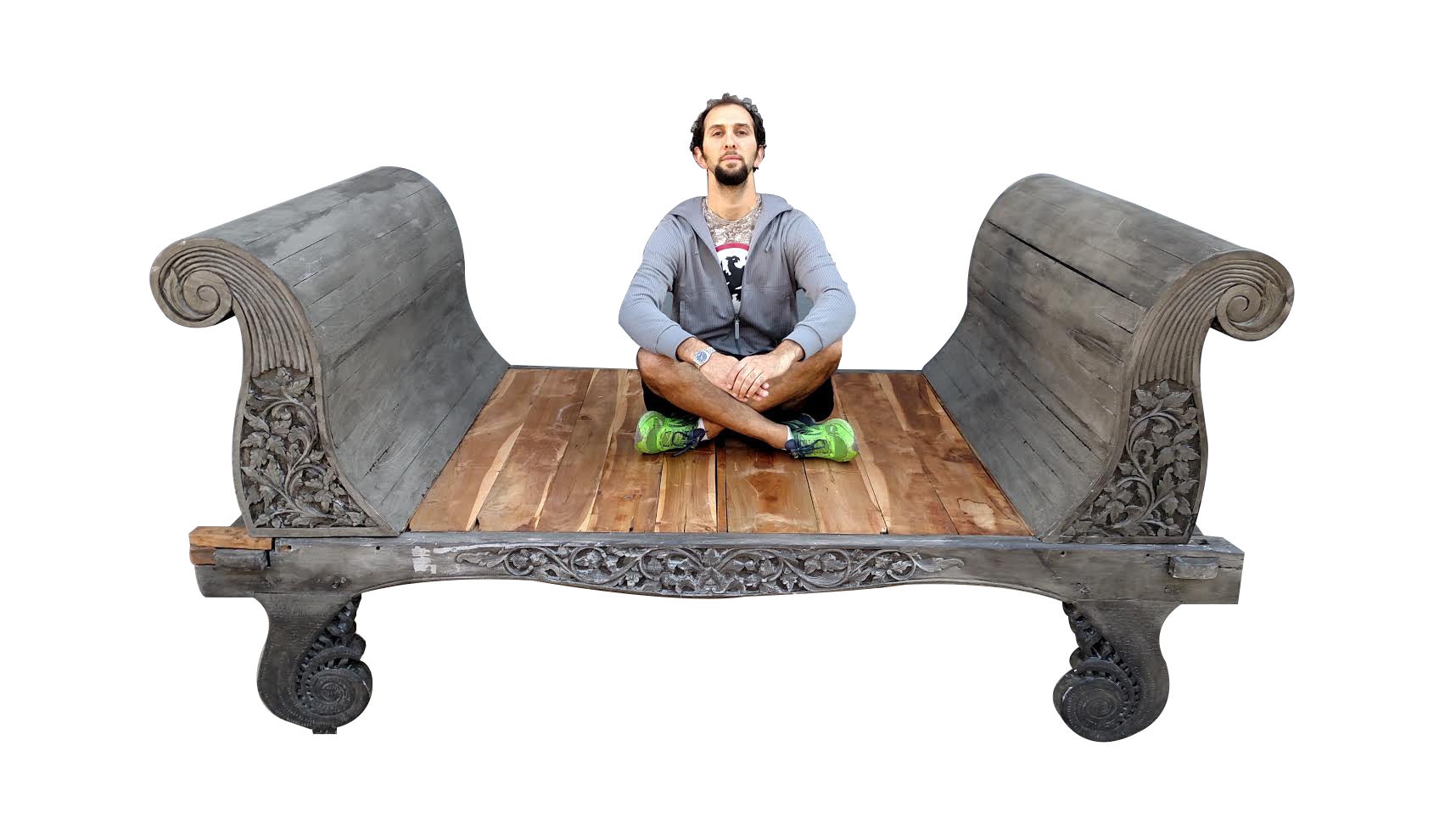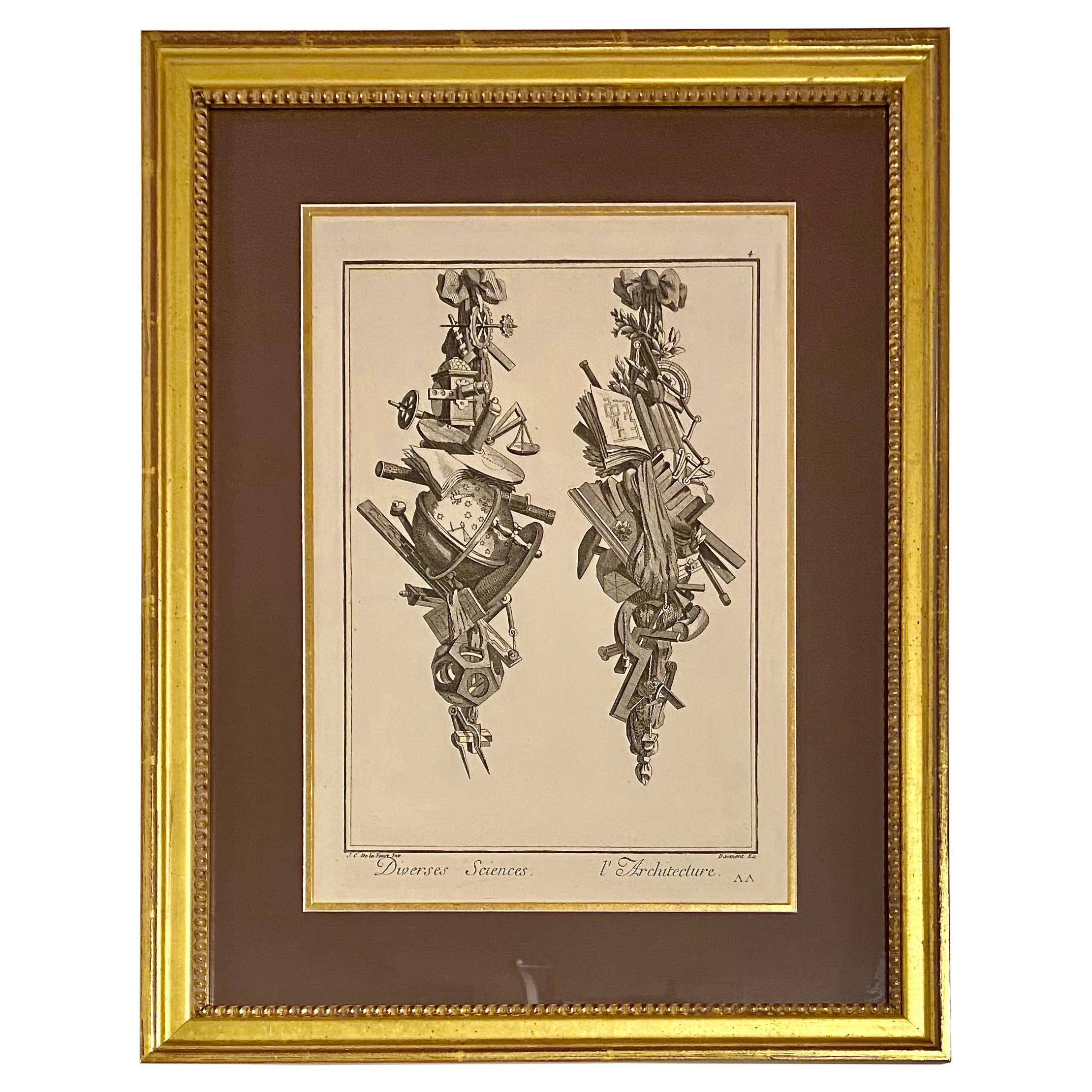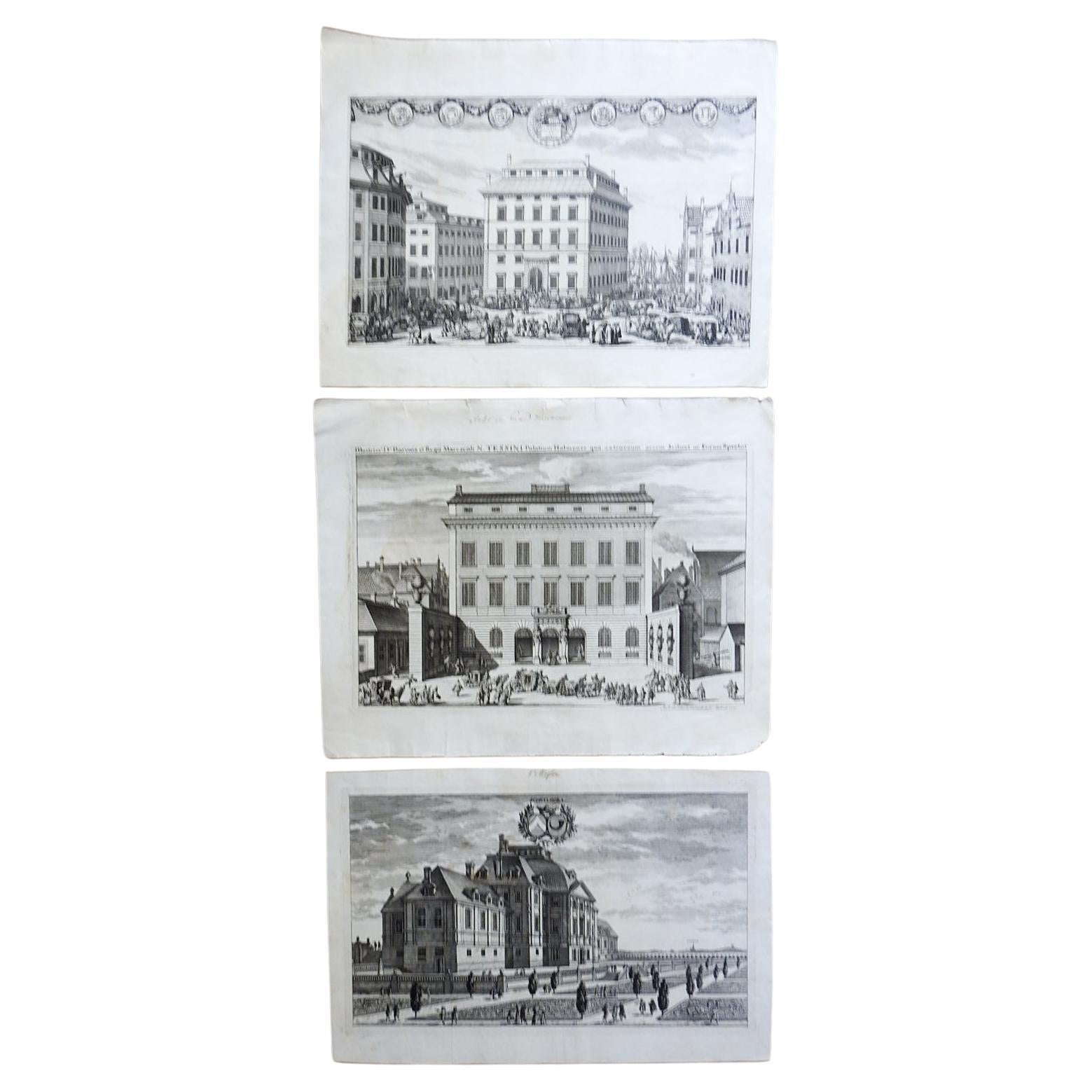Items Similar to 5 Antique 19thC Italian Giulio Ferrari Architectural Renaissance Etchings Gli St
Want more images or videos?
Request additional images or videos from the seller
1 of 13
5 Antique 19thC Italian Giulio Ferrari Architectural Renaissance Etchings Gli St
About the Item
Set of five late 19th century colored Italian architectural etchings from the folio “Gli Stili Nella Forma e Nel Colore – Dalle origini al Rinascimento” (Styles in Shape and Color – From the origins to the Renaissance) by Giulio Ferrari. Engraved by A. Alessio. Published by G. Ricordi & C. of Milan. Copyright by Societa Italiana di Edizioni Artistiche C. Crudo & C. - Torino (Italian Society of Artistic Publishing C. Crudo & C. - Turin)
Plates Included:
Rinascimento: Il Quattrocento (Renaissance: The fifteenth century)
Tav. CXXXII – Venezia, Facciata e abside della Chiesa di S.M. dei Miracoli. (Venice, Facade and apse of the Church of Santa Maria dei Miracoli)
Tav. CLVIII – fig. 1 : Prato, S. Maria delle carceri, particolare del cornicione con fregio Robbiesco – fig. 2 : Esempio di presepio Robbiesco. (Prato, Santa Maria delle Carceri, detail of the cornice with Robbiesque frieze / Example of a Robbiesque crib)
Tav. CXXXV – Venezia, fig. 1 : Scuola di S. Marco, portale della facciata – fig. 2, 3 : Palazzo Ducale, particolare della corte interna. (School of San Marco, portal of the façade / Ducal Palace, detail of the internal courtyard)
Gotico (Gothic)
Tav. CXVII – Fig. 1-2 : - Viterbo, Salone interno del Palazzo dei Papi, decorazioni di strombature delle finestre. Fig. 3 : Viterbo, chiesa della Madonna della salute, porta. - Fig. 4-5 : Padova, Oratorio di S. Giorgio, decorazioni murali. (Viterbo, internal hall of the Palace of the Pope, splayed window decorations / Viterbo, church of the Madonna della Salute, door / Padua, Oratory of S. Giorgio, wall decorations)
Tav. CVI – Fig. 1 : Portovenere (Spezia), Chiesa di S. Pietro. Fig. 2-3 : Genova, Cattedrale di S. Lorenzo, interno e particolare del portale di destra. (Portovenere (Spezia), Church of San Pietro / Genoa, Cathedral of San Lorenzo, interior and detail of the right portal)
“Giulio Ferrari (1858-1934) was an Italian artist, art historian and teacher. After an initial and brief apprenticeship with the 'atelier of painter Reggiano G. Fontanesi, in April of 1878 he enrolled at the Institute of Fine Arts in Florence, where he attended the course of "common figure" under the guidance of U. De Matteis.
Although he then embarked on the path of art-historical studies and teaching, Ferrari is also known for paintings that he made in the last two decades of the nineteenth century.”
Dimensions:
12.5” x 17” (Width x Height)
- Dimensions:Height: 17 in (43.18 cm)Width: 0.125 in (3.18 mm)Depth: 12.5 in (31.75 cm)
- Sold As:Set of 5
- Style:Renaissance (In the Style Of)
- Materials and Techniques:
- Period:
- Date of Manufacture:Late 19th Century
- Condition:Wear consistent with age and use. Good Overall - Some discoloration throughout.
- Seller Location:Dayton, OH
- Reference Number:

About the Seller
4.9
Platinum Seller
These expertly vetted sellers are 1stDibs' most experienced sellers and are rated highest by our customers.
Established in 2010
1stDibs seller since 2020
1,113 sales on 1stDibs
Typical response time: <1 hour
- ShippingRetrieving quote...Ships From: Dayton, OH
- Return PolicyA return for this item may be initiated within 2 days of delivery.
More From This SellerView All
- Antique Architectural Press Cathedral Cityscape Etching After Frank BrangwynBy Frank BrangwynLocated in Dayton, OH"Antique cityscape print “From an Etching by Frank Brangwyn, R.A. A.D. 1922 by The architectural Press. “Frank Brangwyn was born in 1867 in Bruges, Belgium. His family moved back to London in 1875 where he attended school until 1879, when he left as much out of boredom as necessity. His father worked as an architect, muralist, and in other arts-related crafts. Frank helped around the studio and continued his own artistic education by copying drawings at what was to become the Victoria and Albert Museum. His abilities attracted the notice of more established artists and at the age of 15 he was working for William Morris getting rudimentary training and preparing designs for many aspects of Morris' Arts and Crafts output. In 1885, with nothing much more than youthful enthusiasm, he submitted a painting to the Royal Academy Summer Exhibition and was accepted - at the age of 17. Spurred by this success he rented a studio and began a period of productive poverty. With little money, his early work revolved around the sea where traditional subjects for British art were moored and made docile models. This is considered his """"""""grey"""""""" period and the limited palette may be due as much to limited funds as to artistic intent. His 1890 canvas, """"""""Funeral At Sea"""""""" is typical of this period and won a Gold Medal at the 1891 Paris Salon. The young artist was making waves. In 1888, he worked on a freighter for passage to the Near East of Istanbul and the Black Sea. Orientalism was a major force in European art at the time and Brangwyn was as seduced as many artists were with the colors and light of the Mediterranean and African coasts. These trips brought a new palette to his work and something new to British art. The Buccaneers, at right, is from 1892 and the difference between it and his """"""""grey"""""""" period is dramatic. Just as we have movie critics today, art critics proliferated during the 19th century. Walter Shaw Sparrow, in his excellent """"""""Frank Brangwyn and His Work"""""""", devotes several chapters to the reaction of these critics to Brangwyn's art. Opinions were as varied as the two styles shown here, but what is most interesting is the degree of attention being paid to the work of a self-taught 25-year old. Whatever their views of his work, he was not being taken lightly. Not surprisingly, the bright hues and intense light of his new style were not appreciated by the establishment. To put his work in historic perspective, this was a period of Impressionism, Art Nouveau, and the Munich and Vienna Secessions. In British art, Sargent, Whistler, Waterhouse and Draper were popular. Lord Leighton, Burne-Jones and Alma-Tadema were still active. Brangwyn was following none of these men and the critics were at a loss as to how to pigeonhole him. The continental critics in France, Munich and Vienna had no such trouble. He was seen as a most modern and successful artist from the beginning. For his part, Brangwyn followed his own muse and in doing so found himself at the vanguard of the art world. In 1892 he began working as the designer for the new art magazine, """"""""The Graphic"""""""". In 1895 he was asked to paint murals for the notorious gallery, L'Art Nouveau, in Paris. He won medals for his work in Munich and Paris. At the age of 30, while Britain puzzled over how to evaluate his work, the rest of the world viewed him as the definition of modern British art. He illustrated books: """"""""Don Quixote...Category
Vintage 1920s Prints
MaterialsPaper
- 3 Antique Neoclassical Renaissance H Hal Kramer Chicago Campiglia Engravings 6"By Giovanni Domenico CampigliaLocated in Dayton, OHSet of 3 late 19th-early 20th century neoclassical engravings after the work of Giovanni Domenico Campiglia. Prints feature women / children / puttis / cherub figures in classical Ro...Category
Antique Late 19th Century Neoclassical Prints
MaterialsPaper
- 2 Antique Rome Italy Color Engravings St Andrea Church Piazza Turtle FountainLocated in Dayton, OHSet of two antique colored engravings featuring some of the Splendors of Rome – One city street featuring the Church of Saint Andrea and one...Category
Antique 19th Century Neoclassical Prints
MaterialsPaper
- 4 Alvar Sunol Renaixent Renaissance Embossed Surrealist Lithograph PrintsBy Alvar Sunol Munoz-RamosLocated in Dayton, OHSuite titled “Renaixant” (Renaissance) of four framed, original and embossed lithograph prints on Arches by Alvar Sunol Munoz-Ramos, pencil signed and numbered 122/185. circa 1977. Featuring surrealist scenes with gothic architecture and ghosts / angels / muses / musicians and doves. Alvar is known for his technical expertise. He is passionate about his concept of el oficio, the commitment to his vocation and appreciation for the traditional artistic values bequeathed by the masters. Renaissance artists, especially Piero della Francesca, Vermeer and Balthus, are particularly admired by him. He views his work as an inheritance from and devotion to Catalonia, specifically Romanesque art, yet imbued with a modern sensibility. His themes, though varied, remain steadfast in their revelations about the human condition and complexities, about love and peace. Time is a prominent and recurring theme, referencing history and art history. Alvar Suñol Munoz-Ramos was born on January 29, 1935, in Montgat, a Catalan fishing village on the Mediterranean coast near Barcelona. He started painting oils at age twelve, and at age seventeen was accepted at the Escuela Superior de Bellas Artes de San Jorge, the prestigious fine art school in Barcelona. Before graduating from the Belles Artes, he gave his first solo ex- hibition at Galleries Layetana in Barcelona in 1957. Alvar also won the Bolsa de Viaje Alhambra de Granada, a summer scholarship study trip to Granada. At age 18, he entered a painting in a competition for the Young Painters Prize sponsored by the City of Barcelona. His painting won the grand prize, and it is now in the permanent collection of the Museum of Modern Art, Barcelona, Spain. Due to his early artistic successes, Alvar received many invitations for shows in other Spanish cities. During his military service, he submitted one of his canvases for the Institut Francais an- nual painting competition in Barcelona. The Institut Francais awarded him the grand prize and a scholarship to study in Paris. Alvar arrived in Paris to paint in 1959. He met Juan Fuentes, a fellow Spaniard and director of the prestigious Parisian Galerie Drouant. Fuentes encouraged Alvar in his painting and brought Alvar's first group of Paris oil paintings to the gallery. Fuentes' gallery sold the paintings in one week. In 1960 Alvar returned to Barcelona to marry his childhood sweetheart, Rosella Berenguer. They returned to Paris and lived there for ten years. Alvar's paintings were exhibited in the United States for the first time at the Monede Gallery, New York in 1962. Alvar produced his first original lithographs for a one-man show at Galerie Drouant in 1963. Since a decisive solo exhibition in Paris in 1963, Alvar has exhibited regularly throughout Europe, the United States, Canada and Japan. For a comprehensive list of Alvar's museum and private exhibitions, please see the additional in- formation provided. Alvar's hometown of Tiana hosts one of his permanent public installations. In September 2001, a commissioned mixed media mural by Alvar was unveiled. The mural reflects on the four seasons and is affixed to The Four Seasons Building, named in reference to Alvar's mural. In 2003, city officials in Montgat, Spain, commissioned Alvar to create another permanent public installation: an 18-foot sculpture titled Mediterranea dedicated to the city's personality and seaside character, which now stands in the newly opened Plaza de Mallorquines. Perhaps one of the most prestigious honors Alvar has received was in 2006 when Restaura, a Spanish real...Category
Vintage 1970s Renaissance Prints
MaterialsPaper
- Vintage Renaissance Sketch Lithograph of Scholars Philosophers Acrylic FrameLocated in Dayton, OHVintage lithograph sketch or study in the style of the Old Masters of the Renaissance, depicting a male artist at an easel, surrounded by other male figures / scholars / philosophers in various attitudes; pencil signed and numbered 184/270. Mounted in a heavy acrylic frame...Category
Late 20th Century Renaissance Prints
MaterialsPaper
- 2 Italian Fiorenza Floral Botanical Stramonia Cinera cum Flore Colored EtchingsLocated in Dayton, OHPair of vintage framed botanical prints. Ediz. P.V. 21 - I - Cinera cum flore. Ediz. P.V. 17 - I – Stramonia / II – Halmus / III – Botris Dracontiamaioi. Produced by Ediz P.V. Fiore...Category
Late 20th Century Prints
MaterialsPaper
You May Also Like
- Antique Etching Proof, “Washington And His Family” 19thCLocated in Big Flats, NYAntique Presidential Etching “Washington And His Family” Proof, Engraved by Wm. Sartain Philad., Proof Printed by Irwin & Sartain Philad., Framed, c1864 AFTER, Christian Schussele ...Category
Antique 19th Century Prints
MaterialsPaper
- 19thc. Giltwood Architectural ElementLocated in New Orleans, LACarved and Gilded Wood UrnCategory
Antique 19th Century French Architectural Elements
MaterialsWood
- Architectural Etching, Diverses Sciences & l’ArchitectureLocated in Montreal, QuebecArchitectural Print Total of 6 available 2 horizontal & 4 vertical prints Dimensions : Frame: 16” W x 20.25” H x 1” D Etching: 9.5” W x 13.75...Category
Antique Late 19th Century French Neoclassical Prints
MaterialsWood, Paper
- 19thC Engraving of Mozart Playing for Hapsburg Emperor Francis 1Located in Vancouver, British ColumbiaA 19th century engraving of a young Mozart playing the harpsichord in the court of Hapsburg Emperor Francis I featuring the Emperor and a number of courtesans and members of the Haps...Category
Antique Late 19th Century European Louis XV Prints
MaterialsGiltwood, Paper
- Antique 1702 Swedish Baroque Architectural Etchings - Set of 3Located in Seguin, TXSet of 3 antique circa 1702 architectural etchings by Johannes van den Aveelen. Includes the Tessin Palace in Stockholm, Swedish Bank and Schellnora estate. From a large series of ...Category
Antique Early 1700s Swedish Baroque Prints
MaterialsPaper
- Architectural Etching, Gaines 'Columns'Located in Montreal, QuebecArchitectural print Total of 6 available 2 horizontal & 4 vertical prints Dimensions: Frame: 16” W x 20.25” H x 1” D Etching: 9.5” W x 13.75” H.Category
Antique Late 19th Century French Neoclassical Prints
MaterialsWood, Paper





